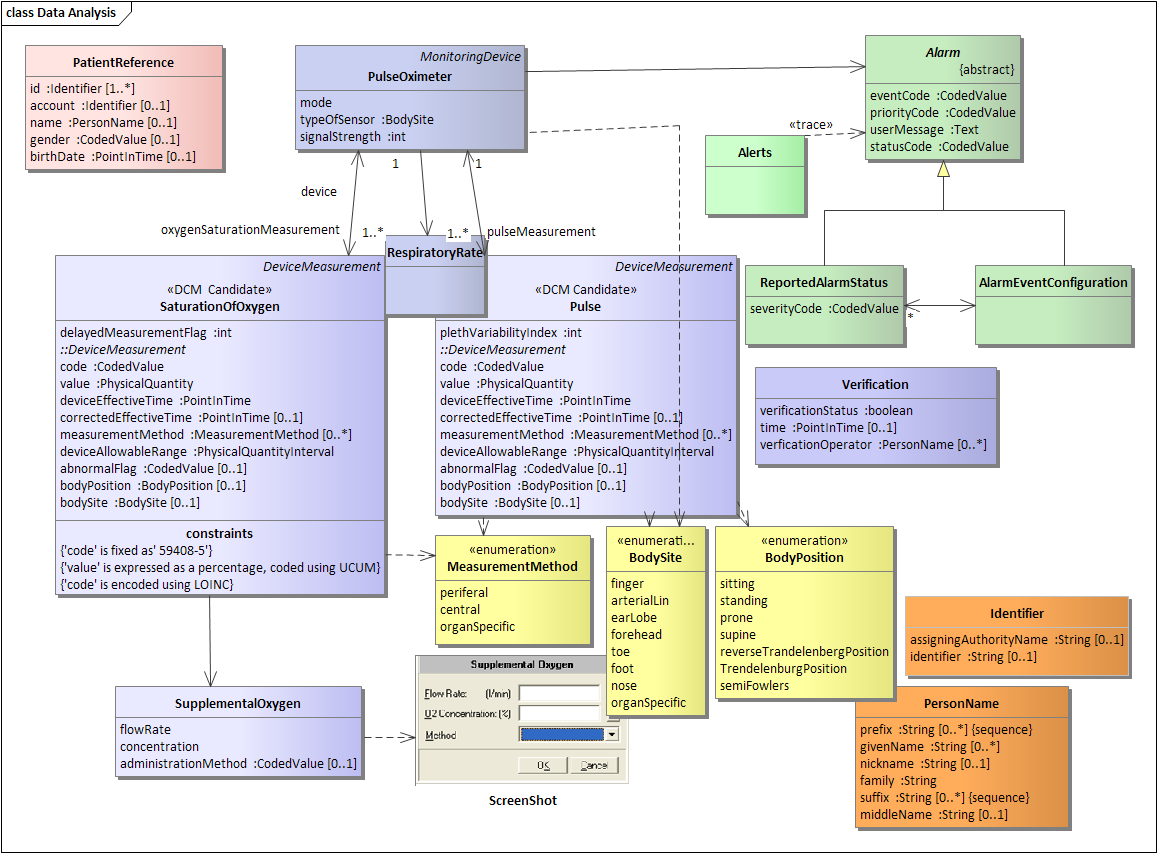2012-03-12 PCD Pulse Oximetry Project Meeting
Weekly Conference Call
Date: Monday, March 12th, 2012 Meeting will start at 1 pm.
Attendees
- Leah Krynicky
- Ioana Singureanu
- Catherine Hoang
- Tom Bauld
- Toni Philips
- Rob Rawlins
- Sean McFarland
- Mike Henderson
- John Rhoads
- Rob Rawlins
- Lee Winslow
- Tocher Kellom
- Ben Loewenbach
Agenda
- (05 min) Roll call and meeting minutes approval
- (50 min) Data Requirements Analysis: We will continue last week's discussion of coded information and expand the discussion to alarm conditions and alerts
- (5 min) Action item update
Meeting Notes
- Data Requirements Analysis: Ioana reviewed the notation and data elements in the workflow analysis.
Ben asked if we will use the Rosetta code. Ioana stated that we plan to use Rosetta and are considering mapping to LOINC and SNOMED-CT. We will mine the existing codes in Rosetta for anything pertaining to device measurement and possibly qualifiers. The recommended terminology is IEEE, but we recognize that most devices do not use this. Once we have the requirements defined, we can leverage or expand on Rosetta. Lee Winslow asked if we have considered how to human-validate the data coming through. Ioana stated that we discussed verification during previous meetings. Verification occurs either at the point of care or on the information system for continuously sent data. Lee stated that devices in the future may require this data at the point of care. He asked if we are keeping a pathway back so that data can be sent back to a device that might need data from another advice. Ioana stated that the use case does not include devices querying for data. Rob Rawlins discussed the inclusion of a notice that data is delayed. Ioana asked if something has not really been measured if we need to see it. Sean stated that if the data is being reported it would be misleading if it's not based on physiological data from the patient. There should at least be a flag or notification that this data is not current. Ben stated that a device will not report a value unless it is physiologically valid but a device will continue to report a value while it attempts to record a new value within the allowable time period. Ioana asked what should be done with delayed data when a clinician goes in to validate the data. Rob stated that it should be kept along with the flag. Ioana stated that "delayed" sounds misleading. Rob stated that he would research the FDA standard. Rob asked if other data such as respiration rate would be reported. Ioana stated that anything recorded by the pulse oximeter should be included. Ioana asked if type of sensor should be included. Rob agreed that it is important, especially for determining if the sensor was placed correctly. Toni Philips recommended Dr. Jim Edwards as a contact for information about the operating room because this is different from critical care. Tom recommended including a variability index. Ioana added body site, body position, and pulse attributes based on participant input.
Links
- Our data analysis identifies the core data elements required to support the use cases. Optional data elements are indicated by the [0..*] cardinality notation and repeating element are specified as [1..*].
 - data analysis as revised on 3/12/2012
- data analysis as revised on 3/12/2012
Action Items
- Toni will reach out to Dr. Edwards and Dr. Gunnar regarding the operating room. Ioana will provide her with background information.
- The draft document will be completed 3/26/2012 and it will be avaiablt to Dr. Edwards
- Rob will send Ioana information about delayed data as well as the distinction between alarms, events, and alerts.
- First, here is the wording from the ISO specification (ISO/EN 9919:2005 Clause 51.101) regarding the SpO2 measurement delay indicator and the Pulse measurement delay indicator. This standard has been replaced by ISO 80601-2-61, but it also includes the 30 second measurement delay guidance.
- ISO 9919:2005: Medical electrical equipment – Particular requirements for the basic safety and essential performance of pulse oximeter equipment for medical use.
- ( Clause 51.101: There shall be an indication that SpO2 or pulse rate data is not current when the data update period is greater than 30 s. There shall be at least a low priority alarm condition generated when the data update period exceeds 30 s.
- These times may be shorter than 30 s and shall be disclosed in the instructions for use. A maximum update period of saturation and pulse rate data shorter than 30 s is recommended for continuous neonatal and diagnostic applications.
- Second, we were discussing alarms versus alerts.
- After investigating this, I do not think the workflow needs to support the concept of an “Alert” as being different from an “Alarm”. However, on some of our Oximeters we distinguish between Physiological alarms and Technical alarms.Here are their definitions from ISO EN 60601-1-8: 2007: A PHYSIOLOGICAL ALARM CONDITION
- (ALARM CONDITION arising from a monitored PATIENT-related variable) and a TECHNICAL ALARM CONDITION (ALARM CONDITION arising from a monitored equipment-related or ALARM SYSTEM-related Variable).
- After investigating this, I do not think the workflow needs to support the concept of an “Alert” as being different from an “Alarm”. However, on some of our Oximeters we distinguish between Physiological alarms and Technical alarms.Here are their definitions from ISO EN 60601-1-8: 2007: A PHYSIOLOGICAL ALARM CONDITION
- First, here is the wording from the ISO specification (ISO/EN 9919:2005 Clause 51.101) regarding the SpO2 measurement delay indicator and the Pulse measurement delay indicator. This standard has been replaced by ISO 80601-2-61, but it also includes the 30 second measurement delay guidance.